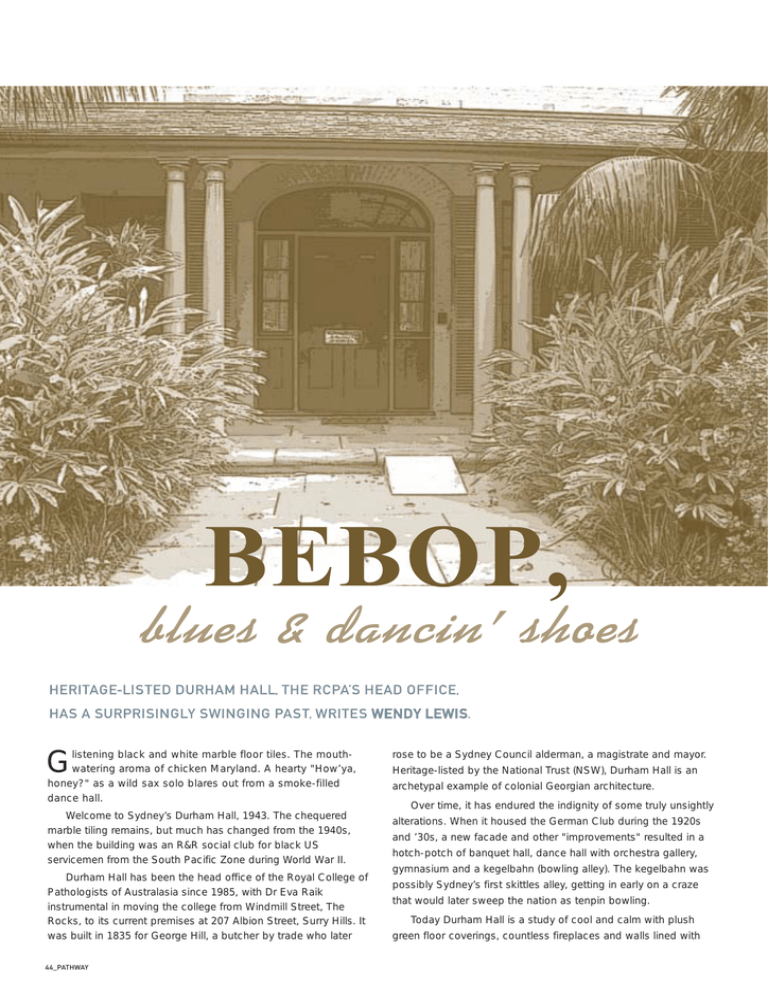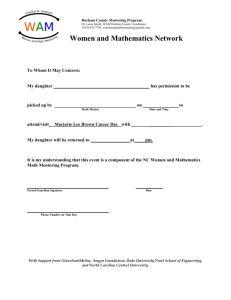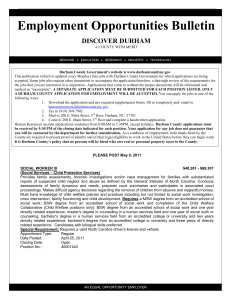BEBOP, blues & dancin’ shoes
advertisement

BEBOP, blues & dancin’ shoes HERITAGE-LISTED DURHAM HALL, THE RCPA’S HEAD OFFICE, HAS A SURPRISINGLY SWINGING PAST, WRITES WENDY LEWIS . listening black and white marble floor tiles. The mouthwatering aroma of chicken Maryland. A hearty "How’ya, honey?" as a wild sax solo blares out from a smoke-filled dance hall. G Welcome to Sydney’s Durham Hall, 1943. The chequered marble tiling remains, but much has changed from the 1940s, when the building was an R&R social club for black US servicemen from the South Pacific Zone during World War II. Durham Hall has been the head office of the Royal College of Pathologists of Australasia since 1985, with Dr Eva Raik instrumental in moving the college from Windmill Street, The Rocks, to its current premises at 207 Albion Street, Surry Hills. It was built in 1835 for George Hill, a butcher by trade who later 44_PATHWAY rose to be a Sydney Council alderman, a magistrate and mayor. Heritage-listed by the National Trust (NSW), Durham Hall is an archetypal example of colonial Georgian architecture. Over time, it has endured the indignity of some truly unsightly alterations. When it housed the German Club during the 1920s and ’30s, a new facade and other "improvements" resulted in a hotch-potch of banquet hall, dance hall with orchestra gallery, gymnasium and a kegelbahn (bowling alley). The kegelbahn was possibly Sydney’s first skittles alley, getting in early on a craze that would later sweep the nation as tenpin bowling. Today Durham Hall is a study of cool and calm with plush green floor coverings, countless fireplaces and walls lined with Left: The entrance to Durham Hall Below: An early drawing of Durham Hall dancin’ shoes commemorative plaques, fine watercolours and portraits of past society presidents. Thanks to a total revamp by Clive Lucas & Partners during the 1980s, the elegant French doors are back in place, opening out to a leafy tropical garden that envelops the building, setting it apart from the harsh brick and sandstone streetscape. All rooms are surprisingly full of natural light and, not so surprisingly, devoid of jazz bands. The late Joan Clarke, co-founder of the Australian Society of Authors, recalls Durham Hall during the war in her memoirs, All On One Good Dancing Leg. From 1943 until the end of the war, the building was known as the Booker T. Washington Club, in honour of the black American educator, and was run by the American Red Cross ("Amcross"). Joan helped out at reception, answering queries from soldiers about the best way to get to Manly Beach or Luna Park, and occasionally enjoying a cold beer and a dance or two. At that time, there was enforced racial segregation and, indeed, many of the women who worked and danced at the club were Aboriginal or Pacific Islanders. Joan recalls that when they set out on bus tours to the South Coast or Blue Mountains, they had to carefully plan stopovers at establishments that would accept "coloured folks". Wednesday and Saturday nights were dance nights. The dance hall was packed with GIs and their dance partners, the atmosphere electric. The house band would start up and Durham Hall would shake to the rhythms of some of Sydney’s top up-and-coming jazz musos, including saxophonists Merv Acheson and Rolph Pommer, guitarist Ray Price and pianist Jim Somerville. Graham Bell passed through – although he never played there – on his way to entertain US troops in Queensland, and Booker T. was one of (a very young) Don Burrows’ first gigs. Jim Somerville, one of the original members of the Port Jackson Jazz Band, is in his 80s now and living on the NSW South Coast. Many know him as the Piano Man from David Jones’ Sydney City Store, but as a budding 16year-old jazz pianist, he played at Booker T. from 1942 until 1944. He loved the freedom to play faster than fast or slower than slow. Glenn Miller’s Jersey Bounce was a big hit of the time, but play lists were often simply thrown out the window. "We played what we could get away with," he says with a hint of mischief. "Songs weren’t important, it was how you played ’em!" Jim gleefully remembers playing fast blues improvisations for 45 minutes while the servicemen jitterbugged like crazy with their partners. "Many girls would get tired and need to sit out," he says, "and the fellas would just grab another girl!" Pansy, one of the young women who danced there, recalls: "I used to like being swirled around, but not thrown over their heads. I would make that clear before I started to dance ... Well, I goes to Booker T. this night. Everybody was there. So we were dancing, you know, and he threw me up in the air. You ... had about four or five petticoats and a beautiful skirt and your hair all pulled up ... and I had scanties on. Oh, my godfather! I heard everybody laughing!" Booker T. was hot, but at 10.30pm it was lights out. Carefully selected soldiers would act as "bodyguards" for the night, walk the young ladies back to the tram stop, see them safely onto the tram to Circular Quay and wave adieu. Now the trams are gone. This part of Surry Hills is full of funky designer shops and huge volumes of traffic heading to the airport, or off to Sydney Cricket Ground, Bondi, Bronte or another of Sydney’s fashion-conscious beaches. It’s hard to imagine now, but when Durham Hall was first built, it would have captured picturesque views over the gentle rolling slopes right down to the harbour. As the city changes around it, Durham Hall retains an aura of quiet grandeur. In the council room, the magnificent Maori carving on display reflects the global concerns of a complex and uncertain world. A plaque in the grounds commemorates the 50th anniversary of the establishment of the Booker T. Washington Club. Inside there is the sound of computer keyboards, telephones and drilling as tradesmen get stuck into maintenance work in the basement. One thing’s for sure: these days, you are unlikely to hear a deep voice ring out, "Mmmmmmm! Mmmm! Tha’s chicken Marylan’ or mah nose is dreaming!" Many thanks to: Tony Barker (City of Sydney Historical Assoc); Jim Somerville (ex-pianist, Booker T); Debbie Deston (RCPA). Refs: Joan Clarke, All on One Good Dancing Leg. Sydney: Hale & Iremonger, 1994; Hindsight (transcript), ABC Radio, c1995. PATHWAY_45




